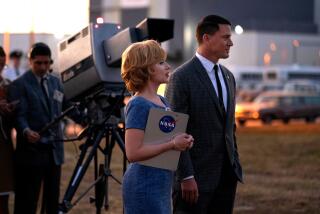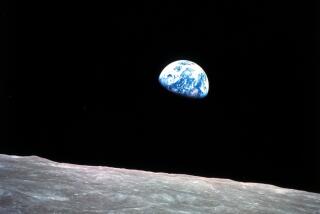‘Challenger’: An Astronaut’s-Eye View
- Share via
Manned spaceflight is dangerous and dramatic. When an ambitious mission succeeds, as did the moon-landing flight of Apollo 11, astronauts like me are hailed as triumphant national heroes for doing our jobs, and the flight directors, contractors and engineers responsible for the success are applauded as visionary geniuses.
But when a supposedly “routine” flight, like the January, 1986 mission of the shuttle Challenger, ends in disaster, the accident assumes the proportions of epic tragedy, replete with victims and villains.
George Englund, the co-executive producer/writer of “Challenger” (ABC, Sunday at8 p.m.), has woven the basic elements of classical tragedy--courage, human weakness and hubris--into an emotionally gripping, indeed epic, television drama.
He had splendid raw material. Challenger’s crew was uniquely American--men and women who epitomized our ethnic diversity and educational opportunities.
Dick Scobee rose through the ranks by hard work and determination to command the shuttle. Black astronaut Ron McNair came from the Jim Crow South to earn a doctorate in physics. Judy Resnik excelled in the traditional male domain of electrical engineering and teacher Christa McAuliffe won a rigorous national competition to gain her seat on the shuttle. Mission specialist Ellison Onizuka was of Japanese descent. They are brought to life so vividly that we are again deeply touched by their loss.
We know now that Challenger was destroyed by the failure of a rocket booster component, a rubbery O-ring hardened by record Florida cold, which sprang into place a fraction of a second too late to contain the rocket’s searing gases.
We also know that the effect of cold weather on these O-rings was the source of an acrimonious debate between NASA and the booster contractor, Morton-Thiokol, for months before the accident. And we know that this debate raged unabated the night before the launch. Given these facts, Englund could have easily sensationalized events and wrung his characters for cheap pathos. Instead, the film is strikingly realistic. The pacing is excellent, and the tension builds inexorably.
Scobee, pilot Mike Smith, mission specialists McNair, Resnik and Onizuka are shown, warts and all, as humans willing to accept the risks of their chosen profession, striving to maintain normal family lives during their hectic training.
McAuliffe, beautifully portrayed by Karen Allen, is a dedicated teacher, literally swept up in the hazardous adventure. The performances are unusually distinctive. Lane Smith, who played President Nixon in ABC’s “The Final Days,” is NASA’s harassed booster manager Lawrence Mulloy. Peter Boyle renders a memorable Roger Boisjoly, the troubled Morton-Thiokol engineer.
The sense of classical tragedy is heightened by Englund’s sharply honed dramatization: Each of the climactic scenes is framed by the stark image of Challenger, poised like an iceberg on the launch pad, while the freezing gale keens. During the 24 hours between a weather scrub and the fatal launch, banal mishaps and “glitches”--botched phone connections, inaccurate weather forecasts, even a leaky shuttle balloon in the crew family waiting room--anticipate the final malfunction.
At one point in the interrupted countdown, Mike Smith, played with understated grace by Brian Kerwin, finally lashes out, saying, “What bothers me is decisions made by people who’ve never flown a plane.”
His frustration epitomizes the crew’s tragic situation: Seven talented but terribly vulnerable people caught up in the relentless march of faceless technocrats that is a shuttle launch.
But “Challenger” is much more than a tale of bureaucratic infighting and domestic tensions. The film is superb visually, evocative of a large-screen production, not a TV docudrama. The scenes of McAuliffe “flying” the T-33 jet trainer under the patient tutelage of Dick Scobee are among the best aviation sequences I’ve ever seen, thrilling but realistic. This combination of gritty realism and visual splendor pervades “Challenger.”
Last summer, George Englund discussed his approach to the project with The Times. His screenplay was based on books, newspaper and magazine accounts and the presidential and congressional investigations of the accident. “Every line in the script is annotated,” Englund said. “I wanted to get it right.”
He certainly got what he wanted. “Challenger” is a winner.
More to Read
Only good movies
Get the Indie Focus newsletter, Mark Olsen's weekly guide to the world of cinema.
You may occasionally receive promotional content from the Los Angeles Times.







